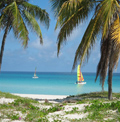 Official reports say 85 cases of cholera have been recorded but the European Centre for Disease Prevention and Control (ECDC) believes the incidence of infection is likely to be much higher. Three local people, all with underlying chronic illnesses, have died from cholera to date.
Official reports say 85 cases of cholera have been recorded but the European Centre for Disease Prevention and Control (ECDC) believes the incidence of infection is likely to be much higher. Three local people, all with underlying chronic illnesses, have died from cholera to date.
Cuba attracts 2.5 million tourists per year, most of which visit during the European winter. Around one third of these are European residents, mostly from Italy, Spain and Germany.
The outbreak is concentrated in the city of Manzanillo, a commercial centre with a population of 150,000 which is not considered to be a major tourist centre. The ECDC says the risk to tourists would be reassessed if the outbreak spreads to other provinces.
The cholera vaccine is not routinely recommended for EU citizens but can be considered in certain cases, such as humanitarian health workers and military personnel stationed in refugee camps, as well as those visiting regions affected by cholera, according to the ECDC’s rapid risk assessment on the outbreak in Cuba.
“Travellers should seek information on how to prevent cholera contamination prior to visiting affected areas. Clinicians should be made aware to keep the possibility of cholera firmly in mind for travellers returning from Cuba who show clinical signs suggestive of this disease,” the ECDC says in a report on the outbreak.
Travel-associated cholera cases reported in Europe are rare and usually associated with travel to the Indian subcontinent and Africa, where outbreaks frequently affect local populations. In 2011, a few imported cholera cases were reported in European travellers returning from the Dominican Republic.
A cholera epidemic in Haiti which began in late 2010 has infected more than half a million and caused 7,000 deaths. The main risk of outbreaks is to local people with poor living conditions and weak – or non-existent – sanitation systems.
However, Cuba’s health infrastructure is considered to be vastly superior to Haiti. Life expectancy is 77.7 years, disease monitoring networks are in place and universal access to healthcare has been in place since the 1960s.
According to the Cuban Ministry of Health, a range of control measures have been implemented to contain the cholera outbreak. These include sampling and closure of contaminated wells, treatment of waste water, removal of water leaks, chlorination of water in the affected areas, cleaning and sanitation of septic tanks, and public awareness campaigns about the importance of good sanitary and hygiene practices.





Chris Salter (@postpolionews) (@postpolionews) (@postpolionews) (@postpolionews)
July 31st, 2012
Cholera in Cuba: should European tourists worry? | Vaccines Today http://t.co/FeaDMGQL #ppnews
Ponchanok RNaBhuket (@tapanok) (@tapanok) (@tapanok)
August 9th, 2012
Cholera in Cuba: should European tourists worry? http://t.co/DfQvHs6X
VaccinesToday (@VaccinesToday) (@VaccinesToday)
August 13th, 2012
#Cholera in #Cuba: should European tourists worry? http://t.co/SbRdkc8j #travelhealth